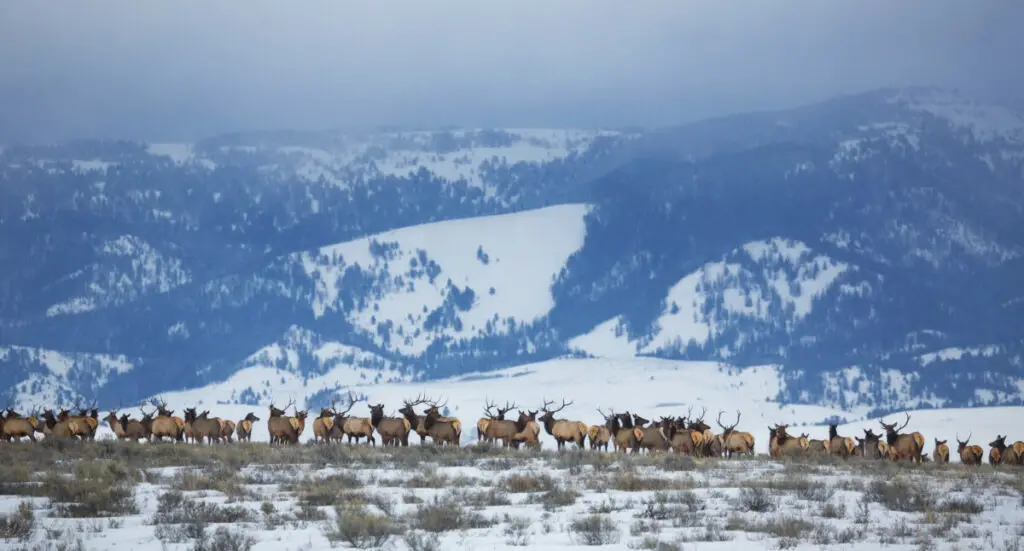
Elk and deer are the most sought-after big game animals in the western United States. This is due to the population sizes and accessibility to hunt these animals. But which one is harder to hunt?
Elk are harder to hunt due to the high altitudes that they inhabit and the speed at which they can cover long distances. Additionally, they are more elusive because of their feeding behaviors.
Feeding habits
Elk and mule deer are similar in the fact that they often occupy the same country. The difference is how they choose to use that country for their survival needs. Elk are creatures that like to graze, similar to a beef cow.
So what does this mean to a hunter? Well, in my experience when hunting elk, you either see some or you don’t. This means you have either found the part of the mountain where the elk are feeding on their given vegetation or you are way off.
So you need to find the big areas that are full of grasses and watch them for some time when you are scouting. If you don’t see any elk after half a day or a day of glassing, then keep moving until you do find some elk. Once you find them, they are known to be creatures of habit.
So rest, assured they will stay in the area unless pushed out by external forces.
You tend to see deer more readily than elk because their feeding habit is browsing. They like to eat the tips of leaves and shrubs and then move on through an area. For this reason, they are more on the move than elk. This means you see more deer than elk.
Physiology
Elk are big. We are talking about a wild animal that is the size of a horse. Their bone structure and massive muscles, also makes them harder to put down than a deer.
You should expect to have large caliber rifle to shoot an elk at long distances or be a well-practiced bow shooter to place an arrow right behind the shoulder for a heart shot.
Once hit, these animals are known to exit the immediate area and may need to be tracked. For this reason, I recommend that after you shoot your first shot, immediately reload your firearm or bow, and then be ready to deliver a second shot.
Tracking
After your first shot, if the elk doesn’t go down immediately, you will need to track them. Sit down and wait for about an hour. You should wait for two reasons.
First, so the animal has time to bleed out. The second reason is to not push the animal even further if he hears you in pursuit.
Because elk are larger and stronger than deer, they can bulldoze their way through thick brush, where a deer may choose to go around. Keep this in mind and look not only for blood droplets but also for broken twigs in brush patches to indicate their escape route.
If all else fails and you lose the trail, start making circles and gradually increasing the size of the circle.
Packing it out
Once you have located your downed elk, the work begins. Cleaning a bull elk is similar to a deer except the size of everything is significantly bigger. Thus, making this part of the hunt again, more difficult than a deer.
If you are hunting solo, and you are planning to pack out the animal on your back, you will most certainly have to quarter the animal, hang the quarters and make multiple trips using a backboard.
Specialized hunting packs like the ALPS OutdoorZ Hunting Backpack or the Cabela’s VersaHunt would be good examples of what type of pack would come in handy for packing out elk quarters.
(Pinetrees and solitude may earn a commission from affiliate links in this article.)
Calling
One more challenge, in elk hunting, is the changes to the rut. If you are hunting during September or early October, you will be in the elk rut. This is different from the mule deer rut which is more in the November time frame.
The elk will be calling during this time and it is prime time to try and lure them into bow or rifle range (if your state allows it). So you will need to learn how to bugle and cow call.
This can be a challenge if you are new to elk hunting. You will find that experienced elk hunters use a reed call that they stick in their mouth. Alone it makes the sound of a cow elk.
However, when blown through a plastic tube, it makes the sound of a bull elk. For a beginner, I would recommend that you just go with an elk bugle that has a mouthpiece already mounted on the tube for mimicking bull elk.
For your cow call, I would recommend using a handheld cow call that you blow on, and you can hang around your neck. They are much easier to use, and you will not have to choke on the reed calls.
More Than Worth It
All the things that make elk hunting a bit more challenging is what makes it such a magical animal to pursue and harvest. It’s like nothing else.
If you are new to elk hunting you will want to check these other posts on the topic to include considering a guide, if you are an out-of-state resident.
- What Should I Bring Elk Hunting: Idaho List
- Are Guided Elk Hunts Worth The Cost: Find Out Here
- The Best Time To Hunt Elk: Master Elk Habits
If you are considering a DIY or OTC (over-the-counter), hunt as a novice, I always recommend joining Facebook groups for your state of interest and calling the state’s fish and game department and talking with a biologist to get some sound advice on how to be successful. Go get em!
(This article was originally published on Pintreesandsolitude.com. If it is now published on any other site, it was done without permission from the copyright owner.)
